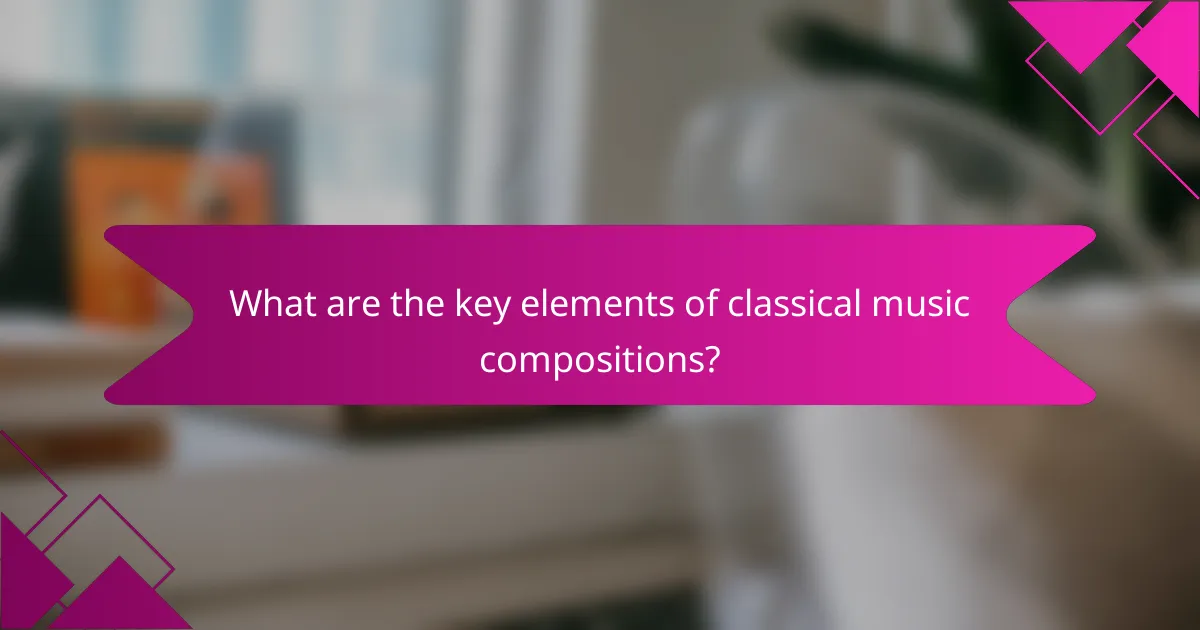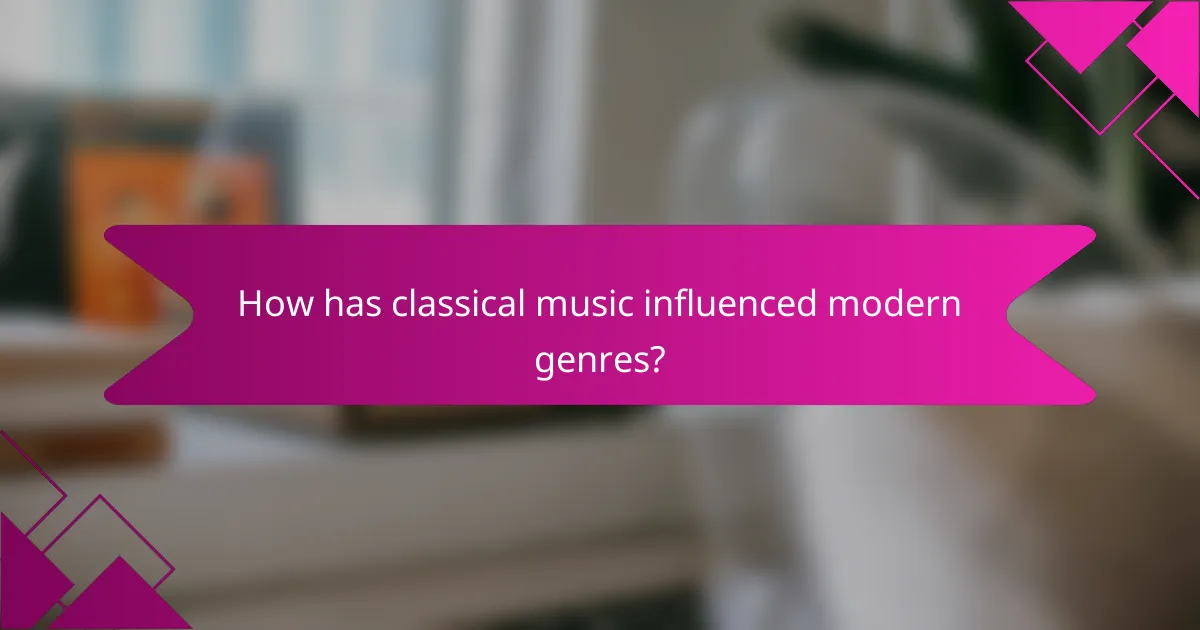Classical music, with its structured compositions and intricate orchestral arrangements, plays a vital role in the cultural landscape, reflecting historical significance and emotional depth. The key elements of melody, harmony, and rhythm come together to create expressive works that resonate with audiences and enhance various experiences, including digital products. Through its rich heritage, classical music continues to inspire and connect people across generations.

How can classical music enhance digital products?
Classical music can significantly enhance digital products by improving user experience, fostering emotional connections, and boosting brand recognition. Integrating orchestral arrangements into digital interfaces can create a more immersive and engaging environment for users.
Improved user engagement
Incorporating classical music into digital products can lead to higher user engagement. The intricate compositions and structured arrangements can captivate users’ attention, encouraging them to spend more time interacting with the product. For instance, background classical music in apps or websites can create a pleasant atmosphere that keeps users focused and interested.
Consider using classical pieces that align with the product’s theme or purpose. For example, a meditation app might benefit from soothing piano sonatas, while a creative design tool could use dynamic orchestral scores to inspire innovation.
Enhanced emotional connection
Classical music has a unique ability to evoke emotions, which can deepen users’ connections to digital products. By selecting pieces that resonate with the intended emotional tone of the product, developers can create a more memorable experience. For example, uplifting symphonies can enhance feelings of joy and motivation, while softer chamber music can promote relaxation and calmness.
To maximize this emotional impact, consider the context in which users engage with the product. Tailoring the musical selection to specific user scenarios can amplify the desired emotional response, making the experience more impactful.
Increased brand recognition
Using classical music strategically can enhance brand recognition by creating a distinctive auditory identity. When users associate specific classical compositions with a brand, it can lead to increased recall and loyalty. For example, a brand that consistently uses a particular symphony in its marketing may become synonymous with that piece, making it instantly recognizable.
To effectively leverage classical music for brand recognition, ensure that the chosen pieces align with the brand’s values and messaging. Consistency in musical selection across various platforms can reinforce the brand’s identity and make it stand out in a crowded market.

What are the key elements of classical music compositions?
The key elements of classical music compositions include melody, harmony, rhythm, tempo, form, and structure. These components work together to create the intricate and expressive nature of classical music, allowing composers to convey emotions and tell stories through their works.
Melody and harmony
Melody refers to the main theme or tune of a piece, while harmony involves the combination of different musical notes played simultaneously to support the melody. A strong melody often serves as the foundation of a composition, while harmony enriches it, creating depth and complexity. Composers may use various harmonic progressions to evoke different emotions, such as tension or resolution.
For example, a simple melody can be accompanied by chords that follow a common progression, like the I-IV-V-I in Western music. This interplay between melody and harmony is essential in establishing the character of the piece.
Rhythm and tempo
Rhythm is the pattern of sounds and silences in music, while tempo refers to the speed at which a piece is played. Together, they create the pulse and movement of a composition. A steady rhythm can provide a sense of stability, while varied rhythms can introduce excitement and unpredictability.
Tempo is often indicated by beats per minute (BPM), with common ranges for classical pieces varying from slow adagios (around 60 BPM) to fast allegros (up to 168 BPM). Composers may also use tempo changes to enhance emotional impact, such as slowing down for dramatic moments.
Form and structure
Form and structure in classical music refer to the overall organization of a composition. Common forms include sonata, symphony, and concerto, each with its own set of rules and characteristics. Understanding these forms helps musicians interpret and perform the music accurately.
For instance, a sonata typically consists of three main sections: exposition, development, and recapitulation. This structure allows for thematic exploration and variation, making it a popular choice for composers. Recognizing the form can aid listeners in following the narrative of the music.

What are the most famous orchestral arrangements?
Some of the most famous orchestral arrangements include works that have significantly influenced classical music and continue to resonate with audiences today. These compositions are characterized by their intricate structures and emotional depth, showcasing the capabilities of orchestras.
Beethoven’s Symphony No. 9
Beethoven’s Symphony No. 9 is renowned for its choral finale, which features the “Ode to Joy.” This symphony is a landmark in classical music, representing the triumph of humanity and brotherhood. Its orchestration includes strings, woodwinds, brass, and percussion, creating a rich tapestry of sound.
The symphony is structured in four movements, with the final movement being particularly notable for its use of vocal soloists and a full choir. When performed, it often evokes powerful emotions, making it a favorite in concert halls worldwide.
Mahler’s Symphony No. 5
Mahler’s Symphony No. 5 is celebrated for its emotional depth and complexity, particularly the Adagietto movement, which is often performed independently. The symphony employs a large orchestra, including expanded brass and woodwind sections, contributing to its dramatic and lush sound.
This symphony is divided into five movements, with the first and last movements showcasing contrasting themes of struggle and resolution. Its orchestration allows for a wide range of dynamics, making it a compelling piece for both musicians and audiences alike.
Stravinsky’s The Firebird
Stravinsky’s The Firebird is a ballet score that revolutionized orchestral music in the early 20th century. It features a vibrant orchestration that includes unique instruments such as the celesta and a large percussion section, creating a magical atmosphere that complements the ballet’s narrative.
The composition is structured in several movements, each depicting different scenes from the story. Its innovative use of rhythm and harmony has made it a staple in the orchestral repertoire, often performed in concert settings as well as in ballet productions.

How has classical music influenced modern genres?
Classical music has profoundly shaped modern genres by introducing complex structures, orchestral arrangements, and emotional depth. Its influence is evident across various platforms, from film scores to pop music and video games, enriching these mediums with its rich heritage.
Impact on film scores
Classical music plays a pivotal role in film scoring, providing emotional resonance and narrative depth. Composers often draw on classical techniques, such as orchestration and thematic development, to enhance storytelling. Iconic scores, like those by John Williams or Hans Zimmer, frequently incorporate classical elements to evoke specific feelings or atmospheres.
For instance, the use of strings and brass can create tension or grandeur, while woodwinds often convey intimacy. Understanding these orchestral arrangements can help filmmakers choose the right music to complement their visual storytelling.
Integration in pop music
Many pop artists integrate classical music elements into their work, blending genres to create unique sounds. This fusion can be seen in the use of orchestral instruments, complex chord progressions, and classical motifs within pop songs. Artists like Adele and Coldplay have successfully incorporated these elements, appealing to a broader audience.
When incorporating classical influences, musicians should consider the balance between pop accessibility and classical complexity. Using strings or piano can enhance a song’s emotional impact without overwhelming the listener.
Use in video games
Video game soundtracks increasingly draw from classical music, enhancing player immersion and emotional engagement. Composers often use orchestral arrangements to create expansive soundscapes that reflect the game’s narrative and environment. Titles like “Final Fantasy” and “The Legend of Zelda” showcase how classical elements can elevate the gaming experience.
Game developers should consider the pacing and emotional tone of their games when selecting or composing music. A well-crafted score can significantly enhance gameplay, making it more memorable and impactful for players.

What are the historical significance and evolution of classical music?
Classical music holds immense historical significance as it reflects the cultural, social, and artistic evolution of societies over centuries. Its evolution from structured compositions to complex orchestral arrangements showcases the changing tastes and influences of different eras.
Development from Baroque to Romantic
The transition from the Baroque period (approximately 1600-1750) to the Romantic era (approximately 1800-1910) marked a significant evolution in classical music. Baroque music, characterized by its ornate melodies and counterpoint, laid the groundwork for the more expressive and emotional styles of the Romantic period.
During the Classical period (1750-1820), composers like Haydn and Mozart introduced clarity and balance, leading to the Romantic composers such as Beethoven and Chopin, who emphasized individual expression and dramatic contrasts. This shift illustrates a move from structured forms to more personal and emotive compositions.
Influence of cultural movements
Cultural movements have profoundly influenced the development of classical music throughout history. The Enlightenment, for instance, emphasized reason and individualism, which shaped the music of the Classical period, promoting clarity and formality.
Similarly, the Romantic movement was influenced by nationalism and the exploration of human emotion, leading composers to incorporate folk elements and personal experiences into their works. This blending of cultural influences enriched the repertoire and expanded the expressive capabilities of classical music.
Role in social change
Classical music has played a pivotal role in social change, often reflecting and influencing societal values and issues. For example, during the French Revolution, music became a means of expressing revolutionary ideals and national identity, with compositions that inspired unity and change.
In the 20th century, composers like Stravinsky and Bernstein addressed contemporary social issues through their works, using music as a platform for commentary and reflection. This ongoing relationship between classical music and social movements highlights its power as a tool for both expression and transformation.

What are the prerequisites for understanding classical music?
To understand classical music, one should have a grasp of basic music theory and be familiar with key composers. These foundations help listeners appreciate the structure, style, and historical context of various compositions.
Basic music theory knowledge
A fundamental understanding of music theory is essential for grasping classical music. This includes knowledge of musical notation, scales, chords, and rhythm. Familiarity with terms like tempo, dynamics, and key signatures can significantly enhance the listening experience.
For example, recognizing the difference between major and minor scales can help listeners understand the emotional context of a piece. Additionally, knowing how to read sheet music can provide insights into the composer’s intentions and the arrangement of instruments.
Familiarity with key composers
Being acquainted with prominent composers is crucial for contextualizing classical music. Figures such as Bach, Mozart, Beethoven, and Tchaikovsky each contributed unique styles and innovations that shaped the genre. Understanding their biographies and the historical periods they represent can deepen appreciation.
Listeners might consider exploring a few signature works from each composer to identify distinct characteristics. For instance, Beethoven’s symphonies often showcase dramatic contrasts, while Mozart’s operas highlight lyrical melodies and intricate harmonies. This familiarity can guide listeners in recognizing stylistic elements across different compositions.
